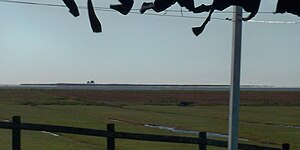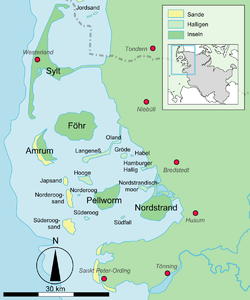Norderoog
| Norderoog | ||
|---|---|---|
| Norderoog from Hooge | ||
| Waters | German Bight , North Sea | |
| Archipelago | North Frisian Islands | |
| Geographical location | 54 ° 31 '41 " N , 8 ° 30' 45" E | |
|
|
||
| length | 640 m | |
| width | 210 m | |
| surface | 9 ha | |
| Highest elevation | 1 m | |
| Residents | uninhabited | |
| main place | (Jens wall hut) | |
| The islands and halligen in the North Frisian Wadden Sea | ||
Norderoog ( Danish Nørreog , North Frisian Noorderuug ) is a Hallig in the Wadden Sea , off the west coast of Schleswig-Holstein with a size of 0.09 km². Apart from the temporary stay of bird observatories , it is uninhabited. The Hallig has belonged to the Jordsand Association since 1909 and is also supervised by them in terms of nature conservation. Administratively it is part of the municipality of Hallig Hooge, which belongs to the North Friesland district . It forms one of the two districts of the Hallig Hooge community and, as the community's (mostly uninhabited) residential space, bears the official residential space number 6.
history
Norderoog was first mentioned in 1597 as "Norder Ough". In 1630 there was a festival estate on the Hallig , which was inhabited by a beach bailiff and which was destroyed in 1634 by the Burchardi flood . Later a family settled again, whose house was robbed by the sea in the February flood of 1825 . From that point on, Norderoog was uninhabited. Today, Norderoog is the only Hallig that no longer has any terps . The former terp has been washed away. The Hallig has been the property of the Jordsand Association since 1909, whose aim is to establish bird sanctuaries on the German North Sea coast.
fauna and Flora
Norderoog serves as a breeding and resting place for many seabirds, some of which are rare. Of greatest importance is the sandwich tern colony ( Thalasseus sandvicensis ). In spring and early summer there are up to 4,000 breeding pairs here every year; in 2007, 2,800 breeding pairs were registered. However, especially inland areas in early summer have a negative impact on the breeding business and can cause strong statistical fluctuations.
Besides breed on Norderoog also river and Arctic terns . For a long time, the oystercatcher on Norderoog was found in the highest breeding pair density in the entire German Bight , but its population declined after 2000. The importance of Norderoog for the bird world arises not only as a breeding area, but also as a resting area for bird migration. At times there are over 50,000 sea birds on the Hallig and the offshore Norderoogsand .
Breeding pair formation
| German name | Scientific name | 2015 | 2017 |
|---|---|---|---|
| Greylag goose | Anser anser | 18th | 48 |
| Shelduck | Tadorna tadorna | 4th | 2 |
| Gadfly | Anas strepera | 1 | |
| Mallard | Anas platyrhynchos | 5 | 7th |
| Eider | Somateria mollissima | 17th | 20th |
| Middle saw | Mergus serrator | 1 | |
| Great crested grebe | Podiceps cristatus | 1 | |
| Oystercatcher | Haematous ostralegus | 50 | 95 |
| Redshank | Tringa totanus | 8th | 9 |
| Black-headed gull | Larus ridibundus | 2398 | 1984 |
| Common gull | Larus canus | 2 | 2 |
| Lesser black-backed gull | Larus fuscus | 38 | 27 |
| herring gull | Larus argentatus | 72 | 43 |
| Black-headed gull | Larus marinus | 2 | 2 |
| Sandwich tern | Thalasseus sandvicensis | 2850 | 2832 |
| Common tern | Sterna hirundo | 28 | 14th |
| Arctic tern | Sterna paradisaea | 93 | 47 |
| Meadow pipit | Anthus pratensis | 7th |
There is typical salt marsh vegetation on Norderoog. Large parts of the holm are with beach Aster and Holm lilac covered. In the sedimentation zone at Halli Grand dominate samphire and cord grass as a pioneer plants. In the highest areas in the east of the Hallig, the beach rye typical of dunes dominates the picture.
protection
Norderoog has been part of protection zone 1 of the Schleswig-Holstein Wadden Sea National Park since 1985 . The Hallig has been officially protected since 1939. However, the Hallig has been a bird sanctuary since 1909, when the Jordsand Association bought it from farmer J. Feddersen for bird protection for 12,000 marks . Before that, Feddersen had made a profit by collecting bird eggs and making hay. Norderoog is the only privately owned German North Sea island. From May 1909 until his death in 1950 Jens Wand lived as a bird warden on Norderoog. The bird protection station on the northeast bank of the Hallig is named after him.
The station, constructed in 1909 as a pile structure , offers protection against storm surges . In addition to this, a second hut was built in 1964, but it was destroyed by a storm surge in January 1976 and replaced by a container construction the following year. The old hut was replaced by the new Jens-Wand hut in 1995/96 . The container was demolished in late 2004. In its place, the bird-keeper's hut, completed in 2005, was built using log cabin technology, which also houses the information room accessible to visitors.
Protection is provided by volunteers from the Jordsand Association. The station is regularly manned from the beginning of March to the end of October. Bank protection has been carried out on Norderoog since the 1950s . In the summer of 1977 a stone edge was laid on the western tip to stop the steady loss of land. It was supplemented in 2000 by a stone groyne .
Workcamps on Norderoog
Norderoog is also known for the international work camps that have been held by the Jordsand association since the 1970s. The up to 20 mostly young adults carry out various work for two weeks to preserve the Hallig, mainly by maintaining the Lahnungen for land preservation . In addition, groups have to be excavated in order to ensure sedimentation in the floodplain fields. Thanks to these operations, it has now been possible to stabilize the Hallig area on a size of around ten hectares.
Movie
On December 7, 2008, NDR broadcast the documentary The Mother Bird. Video diary 2008 - recorded by Anna B. , which was filmed by a young woman. She spent three weeks as a bird keeper on Norderoog as part of a voluntary ecological year at the Jordsand association.
Web links
- Information about Norderoog
- Norderoog on the website of the Jordsand association
Individual evidence
- ↑ Land Registry Office North Friesland ( Memento from May 8, 2008 in the Internet Archive ), accessed on September 30, 2012
- ↑ Christel Grave: Breeding report from our protected and census areas in 2015 . In: SEEBÖGEL . tape 37 , issue 1, March 2016, ISSN 0722-2947 , p. 14-17 .
- ↑ Christel Grave: Breeding report from our protected and census areas in 2017 . In: SEEBÖGEL . tape 39 , issue 1, March 2018, ISSN 0722-2947 , p. 4-7 .






